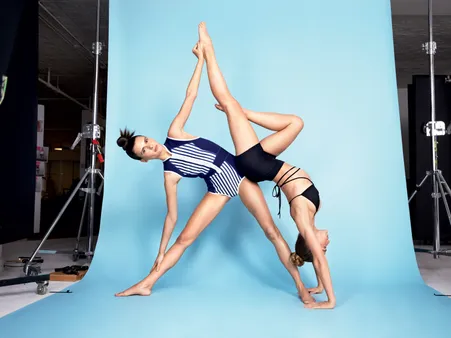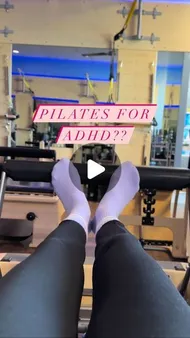Table of Contents
So, you're curious about Pilates and wondering how long it takes to see results? It's a common question, and the answer isn't as simple as a magic number. Like any form of exercise, the time it takes to see noticeable changes depends on a few key factors. This article will explore into the specifics, exploring the factors that influence your progress, providing a timeline of what you can expect, and emphasizing the importance of consistent practice. Whether you're a complete beginner or looking to take your Pilates progression to the next level, understanding these aspects can help you stay motivated and achieve your goals.
Factor | Impact on Results |
|---|---|
Frequency of Practice | More frequent sessions generally lead to faster results. |
Intensity of Workouts | Challenging yourself with appropriate resistance and form will accelerate progress. |
Individual Body Type and Fitness Level | Everyone progresses at their own pace, so be patient with yourself. |
Diet and Lifestyle | A healthy diet and active lifestyle complement Pilates benefits. |
Pilates Results: How Long Does It Take To Work?
How Long Does It Take for Pilates to Work?
Let's get real, we all want to see results, right? Like, how long until my core is strong enough to do a hundred crunches without collapsing? Or when will my posture be so good that I can walk past a mirror without feeling like a hunchback? It's all about that "how long" question, and it's a good one! Here's the thing, though, there's no magic number. It's like baking a cake - some recipes take longer than others. But the good news is, you'll start noticing things pretty quickly.
Feeling the Difference
Pilates is about more than just how your body looks. It's about how it feels, how it moves, and how it responds to your everyday life. You might not see a major change right away, but you'll definitely feel the difference! Think of it like a marathon, not a sprint. You're building a foundation, and that foundation takes time. You'll start noticing things like your posture getting better, your balance improving, and maybe even your breathing getting easier. It's a gradual process, but it's a powerful one. And trust me, it's worth it.
Seeing the Changes
So, you've been doing Pilates for a while, and you're starting to feel the benefits. Now you're wondering when those changes are going to show up in the mirror. Well, that's where the real fun begins! You're going to start noticing changes in your body, like a little more definition in your muscles, a little more flexibility in your spine, and a little less... well, you know, that extra stuff. It's like a slow-burn, but it's a beautiful burn. You're not going to be a bodybuilder overnight, but you'll be amazed at how much stronger and more toned your body can become.
The Time It Takes
Now, let's talk about that magic number. It's usually around 3 to 6 weeks, but it can vary depending on how often you practice and how intense your workouts are. Some experts say you might even start to see changes in just a few weeks! But remember, everyone's different. If you're super new to exercise, it might take a little longer to see results. But don't get discouraged. Just keep practicing and you'll get there.
Frequency | Expected Results |
|---|---|
2-3 times a week | Increased flexibility, improved balance, and strengthening |
3-4 times a week | More noticeable muscle definition, improved posture, and increased core strength |
5-6 times a week | Significant muscle growth, improved athletic performance, and increased confidence |
Factors Influencing Pilates Results
Alright, so we've established that there's no one-size-fits-all answer to the "how long" question. It's like asking how long it takes to learn a new language - some people pick it up faster than others. But we can break down some key factors that influence your Pilates trip.
Frequency of Practice
Just like practicing your piano scales or learning a new dance move, the more you do Pilates, the faster you'll improve. It's like building a house - the more bricks you lay, the faster the walls go up. If you're a beginner, starting with 2-3 sessions a week is a good place to begin. As you get stronger, you can gradually increase the frequency. But remember, quality over quantity! It's better to have a few really good sessions than a bunch of half-hearted ones. The key is to listen to your body and find a rhythm that works for you. I know, I know, it sounds like a lot of work, but trust me, it's worth it. You'll feel amazing!
Intensity of Workouts
Think of it like this: if you're just gently rocking a baby in a cradle, you're not going to build any serious biceps. But if you're lifting weights or doing intense calisthenics, you're going to see some serious gains. The same goes for Pilates. If you're not challenging yourself, you're not going to see as much progress. But that doesn't mean you have to go all out every time. Start with a level of intensity that's comfortable for you, and gradually increase the challenge as you get stronger. It's like climbing a mountain - you start with a gentle slope, and then you gradually work your way up to the steeper parts. Just remember to listen to your body and don't push yourself too hard. You want to build strength, not injuries. And if you're not sure about the intensity, talk to your instructor. They're there to help you reach your goals safely and effectively. It's a team effort, and they're your coach. So, don't be afraid to ask for guidance.
Individual Body Type and Fitness Level
Here's the thing: we're all different. Some people are naturally more flexible, while others have more muscle mass. Some people are brand new to exercise, while others are seasoned athletes. It's like comparing apples and oranges - we're all unique. So, don't compare yourself to others. Focus on your own progression and celebrate your own progress. It's about you, not anyone else. You're doing this for yourself, and that's what matters. And remember, there's no such thing as a "perfect" body. It's all about finding what works for you and feeling good in your own skin. So, embrace your individuality and be proud of your progress, no matter how big or small it may seem.
- Listen to Your Body: Pay attention to how you feel during and after Pilates. If something hurts, stop and adjust. You're not a robot. You're a human being. And humans need to listen to their bodies. It's like a car - if you ignore the warning lights, you're going to end up with a breakdown. So, take care of yourself! And if you're not sure about anything, talk to your instructor.
- Be Patient: It takes time to build strength, flexibility, and a strong core. Don't expect to see results overnight. It's like a garden - you have to nurture it and give it time to grow. So, be patient with yourself and enjoy the process.
- Celebrate Your Progress: No matter how small your progress may seem, celebrate it! It's a big deal! You're working hard, and you're making progress. So, give yourself a pat on the back and keep going. You're amazing!
Pilates and Body Transformation: A Timeline
Okay, let's talk about some general timelines. Remember, these are just general guidelines - everyone's different. But it can give you a rough idea of what to expect. It's like a roadmap, but you can always take detours and explore new paths. It's your progression, and you're in control.
The First Few Weeks
You're going to feel like you're getting stronger, more flexible, and more balanced. You might not see a huge difference in your body yet, but you'll definitely feel it. Think of it like a seed - you've planted the seed, and now you're starting to see the sprout. It's a small change, but it's a powerful one. Keep going, and you'll be amazed at how much you can grow.
The First Few Months
Now you're starting to see some real changes in your body. You're going to notice that your posture is getting better, your muscles are getting stronger, and your core is feeling more stable. You're starting to feel more confident in your body, and you're starting to see the results of your hard work. Think of it like a tree - you've planted the seed, and now you're seeing the branches and leaves start to grow. It's a beautiful sight, and it's a testament to your dedication.
The Long Game
The longer you practice Pilates, the more you'll benefit. You're going to feel stronger, more flexible, and more balanced than ever before. You'll be able to move with more grace and ease, and you'll be able to do things you never thought you could. Think of it like a redwood tree - it takes time to grow, but it's a majestic sight. It's a symbol of your strength, resilience, and dedication. So, keep going! The trip is just as important as the destination.
Consistency is Key: The Strength of Regular Practice
Okay, so you've got the basics down. You know how long it takes to see results, and you understand that everyone's different. But here's the secret sauce: consistency! It's like brushing your teeth - you don't just brush them once a year and expect a pearly white smile. You have to do it regularly. The same goes for Pilates. If you want to see real results, you have to stick with it. It's like a marathon, not a sprint. You have to keep going, even when it gets tough. You have to keep showing up for yourself, even when you don't feel like it. And the more you practice, the easier it will become. It's like learning to ride a bike - it's hard at first, but once you get the hang of it, it becomes second nature. So, keep practicing, and you'll be amazed at how much you can achieve.
I know it can be tempting to skip a session here and there, but trust me, it's worth it to stick with it. The more you practice, the more you'll see the benefits. And the more you see the benefits, the more motivated you'll be to keep going. It's a beautiful cycle. So, don't give up on yourself. Keep practicing, and you'll reach your goals. And when you do, you'll feel amazing! It's like reaching the summit of a mountain - it's a challenging climb, but the view from the top is breathtaking. So, keep climbing! You've got this!
How Long Does It Take for Pilates to Work?
Factors Influencing Pilates Results
Alright, so we've established that there's no one-size-fits-all answer to the "how long" question. It's like asking how long it takes to learn a new language - some people pick it up faster than others. But we can break down some key factors that influence your Pilates trip.
Frequency of Practice
Just like practicing your piano scales or learning a new dance move, the more you do Pilates, the faster you'll improve. It's like building a house - the more bricks you lay, the faster the walls go up. If you're a beginner, starting with 2-3 sessions a week is a good place to begin. As you get stronger, you can gradually increase the frequency. But remember, quality over quantity! It's better to have a few really good sessions than a bunch of half-hearted ones. The key is to listen to your body and find a rhythm that works for you. I know, I know, it sounds like a lot of work, but trust me, it's worth it. You'll feel amazing!
Intensity of Workouts
Think of it like this: if you're just gently rocking a baby in a cradle, you're not going to build any serious biceps. But if you're lifting weights or doing intense calisthenics, you're going to see some serious gains. The same goes for Pilates. If you're not challenging yourself, you're not going to see as much progress. But that doesn't mean you have to go all out every time. Start with a level of intensity that's comfortable for you, and gradually increase the challenge as you get stronger. It's like climbing a mountain - you start with a gentle slope, and then you gradually work your way up to the steeper parts. Just remember to listen to your body and don't push yourself too hard. You want to build strength, not injuries. And if you're not sure about the intensity, talk to your instructor. They're there to help you reach your goals safely and effectively. It's a team effort, and they're your coach. So, don't be afraid to ask for guidance.
Intensity Level | Description |
|---|---|
Beginner | Focus on form and technique, using lighter resistance |
Intermediate | Increase resistance and challenge yourself with more complex movements |
Advanced | Push your limits with advanced exercises and higher repetitions |
Individual Body Type and Fitness Level
Here's the thing: we're all different. Some people are naturally more flexible, while others have more muscle mass. Some people are brand new to exercise, while others are seasoned athletes. It's like comparing apples and oranges - we're all unique. So, don't compare yourself to others. Focus on your own progression and celebrate your own progress. It's about you, not anyone else. You're doing this for yourself, and that's what matters. And remember, there's no such thing as a "perfect" body. It's all about finding what works for you and feeling good in your own skin. So, embrace your individuality and be proud of your progress, no matter how big or small it may seem.
Diet and Lifestyle
You know, it's not all about Pilates! What you eat and how you live your life can also affect your results. If you're constantly eating junk food and sitting on the couch, you're not going to see the same progress as someone who eats healthy and stays active. Think of it like a car - if you put bad gas in it, it's not going to run as well. The same goes for your body. If you put bad stuff in it, it's not going to function as well. So, make sure you're fueling your body with good food and getting enough exercise. And if you're not sure where to start, talk to a doctor or nutritionist. They can help you create a plan that's right for you. You're not alone in this progression. There are people who can help you reach your goals.
- Listen to Your Body: Pay attention to how you feel during and after Pilates. If something hurts, stop and adjust. You're not a robot. You're a human being. And humans need to listen to their bodies. It's like a car - if you ignore the warning lights, you're going to end up with a breakdown. So, take care of yourself! And if you're not sure about anything, talk to your instructor.
- Be Patient: It takes time to build strength, flexibility, and a strong core. Don't expect to see results overnight. It's like a garden - you have to nurture it and give it time to grow. So, be patient with yourself and enjoy the process.
- Celebrate Your Progress: No matter how small your progress may seem, celebrate it! It's a big deal! You're working hard, and you're making progress. So, give yourself a pat on the back and keep going. You're amazing!
Pilates and Body Transformation: A Timeline
Alright, so you've been doing Pilates for a bit, and you're feeling stronger, more flexible, and maybe even a little less wobbly. But when will those changes start showing up in the mirror? Well, imagine your body is like a garden. You've just planted the seeds, watered them, and given them some sunshine. You're not going to see a giant sunflower overnight, but you'll start to see tiny sprouts popping up after a few weeks. That's what Pilates is like! You're building a foundation, and that takes time.
After a few weeks, you might notice some changes in your posture. You'll be standing taller, and your back might feel straighter. You'll also feel stronger in everyday activities, like carrying groceries or climbing stairs. It's like you're getting a little bit more "oomph" in your step!
- You'll be able to stand taller and straighter.
- You'll feel stronger in everyday activities.
- You'll be able to move more easily and with less effort.
After a few months, you'll start to see more noticeable changes in your body. Your muscles will be more defined, and you might even see a little more definition in your abs. You'll also be more flexible and have a wider range of motion. It's like you're slowly blossoming into a beautiful flower!
Over time, as you keep practicing Pilates, you'll continue to see amazing changes in your body and how it moves. It's a process, and it's worth it!
Timeframe | Changes |
|---|---|
2-3 weeks | You'll start to feel stronger, more flexible, and more balanced. |
3-4 months | You'll see more noticeable changes in your body, including increased muscle definition and improved posture. |
6-12 months | You'll experience significant improvements in your strength, flexibility, and overall fitness. |
But remember, everyone's different, so don't compare yourself to others. Focus on your own trip and celebrate your own progress. It's like a marathon, not a sprint. Just keep practicing, and you'll see amazing results!
Pilates and Body Transformation: A Timeline
Consistency is Key: The Strength of Regular Practice
You know, it's tempting to skip a Pilates session now and then, especially when you're feeling tired or busy. But trust me, it's like trying to build a sandcastle on the beach – if you keep stopping and starting, it'll never be as strong or impressive.
Don't Be a Flake
Consistency in Pilates is like building a house – brick by brick, you create a strong and lasting structure. If you're a beginner, starting with 2-3 sessions a week is a good place to begin. It's like warming up your muscles for a big game. As you get stronger, you can gradually increase the frequency, but remember, quality over quantity. It's better to have a few really good sessions than a bunch of half-hearted ones.
Listen to Your Body
Remember, everyone's different. Listen to your body and find a rhythm that works for you. It's like finding the perfect playlist for your workout – it's got to keep you motivated and moving! You'll feel amazing when you start seeing results, and that will keep you coming back for more. I know, I know, it sounds like a lot of work, but trust me, it's worth it! You'll feel like a whole new person.
Keep Showing Up
You've got this! Keep showing up for yourself, even when you don't feel like it. It's like training for a marathon – you've got to keep running, even when your legs feel like jelly. The more you practice, the easier it will become. It's like learning to ride a bike – it's hard at first, but once you get the hang of it, it becomes second nature. So, keep practicing, and you'll be amazed at how much you can achieve.
Consistency is Key: The Strength of Regular Practice
Final Thought
The process of Pilates is about more than just physical changes; it's about building strength, flexibility, and a deeper relationship with your body. While seeing results can be motivating, remember that the true reward lies in the process itself. Embrace the process, be patient with yourself, and enjoy the transformative strength of Pilates. Ready to start your Pilates process? Check out our website, kizworld, for more information and resources to help you get started.